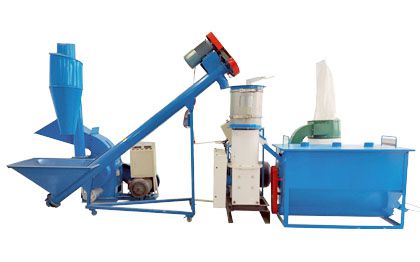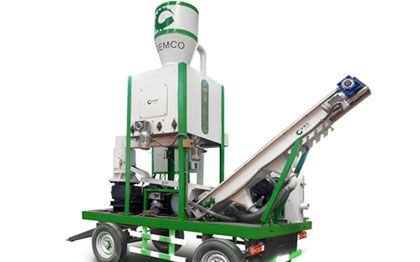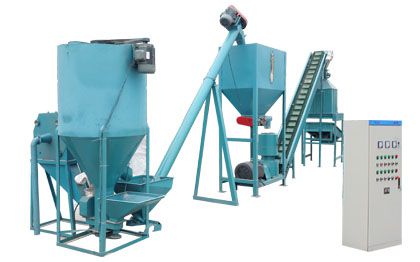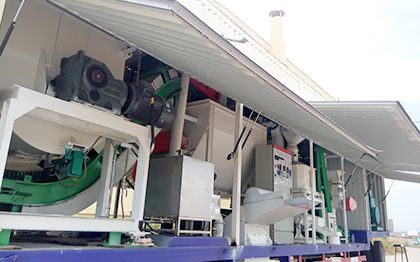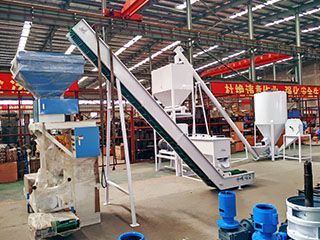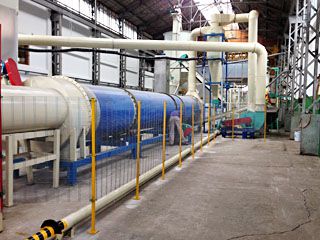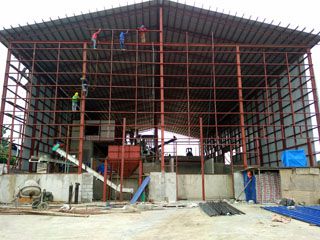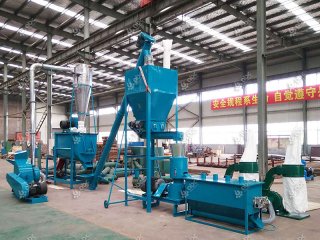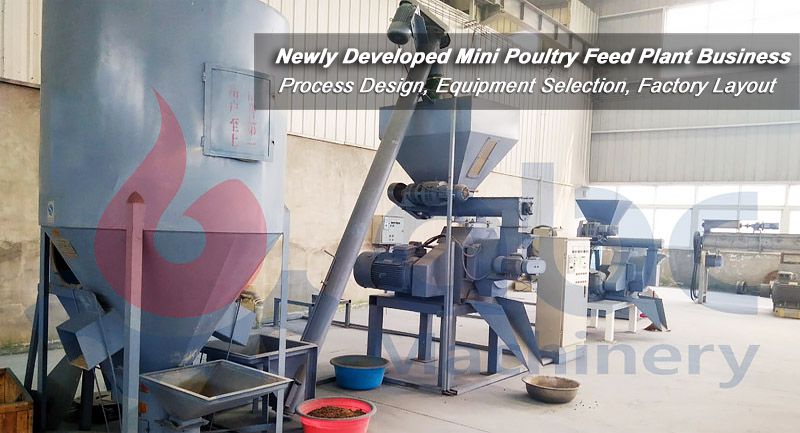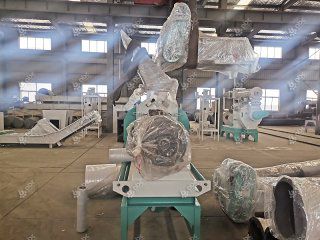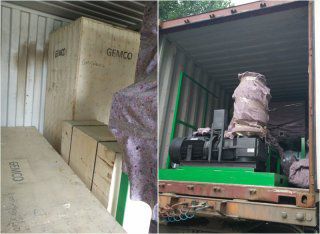Cattle feed pellets need to be made with formulation and process in mind. Precise proportioning and good process are key to ensuring feed quality and nutritional balance. A well-made pelleted feed can provide a high-quality, well-rounded, and nutritious food that improves cattle productivity and health. In this article, we will introduce the advantages of cattle pellet feed, details of the cattle feed production process, and finally explain the ingredients of cattle feed formula and provide cattle feed recipe table for your reference.
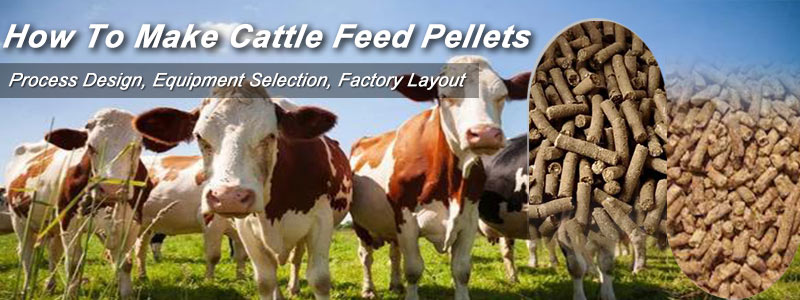
How to Make Cattle Feed Pellets
Advantages of Cattle Feed Pellets: Superior Form of Animal Feed
- Save Cattle Feed: Cattle fed powdered feed, easy to make cattle picky and powder easy to waste, and utilization rate of only 92%. Pellet feed can't make cows picky and the utilization rate of feed pellets can reach 99%.
- Good Palatability: After processing pellets for cattle feed, cattle feed product can increase the flavor, stimulate the cattle's appetite, increase the amount of food intake, and improve the digestibility of feed.
- Promote the Growth and Development: Because the surface of the processed pellets by cattle feed pellet machine is smooth, hard, and deeply cooked. Cattle pellet food has a high digestive efficiency, which promotes the growth and development of cattle. Especially for steer, research shows that pellet feed can significantly increase the average daily weight gain of fattening cattle, reduce the feed-to-weight ratio of beef cattle, and improve the meat quality of beef cattle.
- Longer Storage Time: Powdered feed itself contains about 15% moisture, and it is easy to absorb moisture and deteriorate lumps, and then lose feeding value. When powdered feed is processed into pellets by cattle pellet machine, part of the moisture is lost, and the processed pellets contain about 13% moisture. Under good storage conditions, pellet feed can be stored for 3-4 months without deterioration.
Learn more about the features and benefits of cattle feed.
Cattle Feed Manufacturing Process: From Raw Materials to Pellets
Whether you want to run your own cattle feed pellet plant or make feed pellets for farm, the cattle feed pellet manufacturing process goes through several steps.
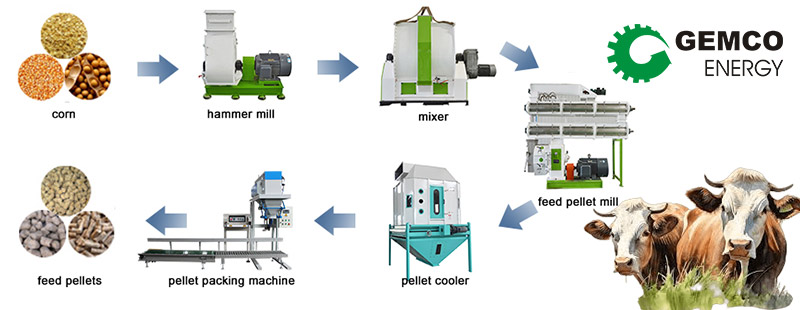
Cattle Feed Pellet Manufacturing Process Flow Chart
- Raw Material Selection and Cleaning:
Select high quality raw materials to remove impurities and substandard products. The purpose of feed cleaning is not only to ensure the quality of finished products, but also to ensure the safe production of processing equipment.
- Crushing of Raw Materials:
Crush or grind some large particles of raw materials. Generally, the crushing size of lactating cattle is not more than 1.0mm, and the crushing size of other cattle is not more than 2.0mm.
- Ingredient Mixing:
Put all kinds of raw materials into the mixer machine according to the proportion of the cattle pellet feed formulation to make sure the mixing is even.
- Pelletizing:
The mixed feed ingredients are pelletized through an animal feed pellet machine. Animal food pellet machines usually form pellets by extruding, squeezing, and cutting. The parameters of the animal feed pellet maker machine and the dies are adjusted to obtain pellets of the desired size. Typically, the cattle feed pellets specifications require the appropriate particle size for cattle feed ranges from 4.5-8mm. Length is 1.5 to 2.5 times the diameter.
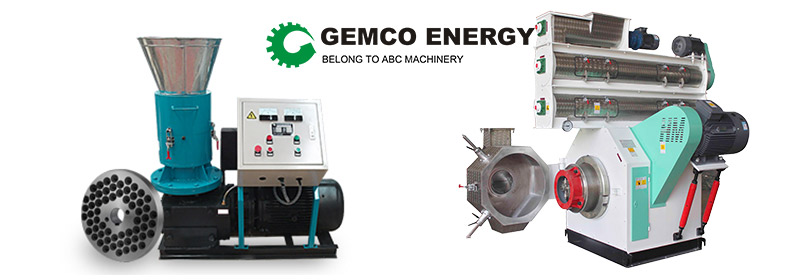
Flat Die Cattle Feed Pellet Mill & Ring Die Cattle Feed Pellet Mill
How to choose the best pellet machine for cattle feed?
There are two main types of animal pellet feed machines: flat die pellet feed machine and ring die pellet feed machine.
- Flat Die Feed Pellet Mill:
Flat die feed pellet machine is cheap, simple structure, easy to operate, and more adaptable to raw materials, so it is very popular among small farms and ranges. Flat die pellet feed mills are often used as small cattle feed pellet machines for home feeders,. If you want to make your own cattle feed pellets at home, you can choose to buy a flat die feed pellet mill. (Link to Small Cattle Feed Plant Cost>>)
- Ring Die Feed Pellet Mill:
Ring die feed pellet machines are more suitable for large-scale feed pellet plant production. Compared to flat die feed pellet mills, ring die pellet feed mills are more complex and have have higher output. In addition, ring die pellet feed machines are superior in terms of pellet density and hardness. It plays an important role in producing higher quality pellets feed.
- Drying and Cooling:
Freshly made feed pellets contain high moisture content which needs to be controlled in the range of 10-12% by drying equipment to prevent mold and prolong shelf life. After drying, the pellets need to be cooled with a cooler machine.
- Sieving and Packaging:
The pellets are sieved to remove unqualified or fine particles. Finally, the feed pellets are packed into bags with a packing machine, usually plastic or woven bags, to ensure that they are sealed for preservation.
If you have any doubts about cattle feed pellet production line, you can contact us to get free and professional answers.
Cattle Feed Pellet Formulas: Ingredient Analysis and Practical Examples
Cattle feed pellets formula varies depending on the needs of the cattle (cow, steer, calf), the environment and production goals. Best cattle feed should contain a balanced blend of protein, carbohydrates, and vitamins. However, how to make cattle feed pellets with balanced nutrition? I hope the following will help you make your cattle feed. I will briefly describe the key nutrients in cattle feed pellet formulation and provide an example fattening cattle feed formulas of rapid weight gain at different growth stages.

Raw Materials of Cattle Feed Pellets
- Crude Protein: This is the total amount of protein in a cattle food and is usually derived from plant or animal ingredients such as soybean meal, corn, fish meal, etc. For feeding cattle pellets, protein is essential component for growth and health of cattle. And usually, the content is 8 to 20%.
- Crude Fat: This refers to the fat content of a feed, which comes from ingredients such as oils and fat. Fat is an important source of energy and aids in the absorption of nutrients. Crude fat content in cattle feed ranges from 2% to 5%.
- Crude Fiber: This is the indigestible plant fiber portion of the feed, such as straw and soybean residue, which is typically 5% to 25%. They are all important for digestive health and motor function in cattle.
- Ash: This is the non-combustible inorganic material in cattle feed pellets, such as minerals and mineral salts. It provides trace elements needed by the animal's body.
- Carbohydrates: It is mainly from grains, corn, etc. It is the main source of energy and supplies the energy needed for various physiological activities in the body.
- Vitamins and Minerals: Vitamins and minerals, such as vitamins A, D, E, etc., as well as calcium, phosphorus, magnesium, etc., are present in trace form in the cattle pellet feed.
- Antibiotics or Additives: Sometimes antibiotics or other nutritional additives are added to cattle range pellets to improve cattle health and performance. However, these additives need to be used with caution to avoid adverse effects on the animals and the environment.
For different feed formula ingredients and output, cattle feed pellet production line should choose different production equipment. If you have any questions about cattle feed pellet production equipments, you can consult us to get free answers!
Beef Cattle Fattening Feed Recipe (Diet)
| Ingredients / % | Pre-Term Cattle Fattening Feed | Mid-Term Cattle Fattening Feed | Late Cattle Fattening Feed |
|---|---|---|---|
| Corn | 15.95 | 19.20 | 25.90 |
| Soybean Hulls | 1.74 | 0.00 | 0.00 |
| Bran | 1.74 | 3.20 | 3.15 |
| Cottonseed Meal | 2.32 | 2.56 | 1.05 |
| Soybean Meal | 1.45 | 0.00 | 0.00 |
| Flax Meal | 0.00 | 2.56 | 0.00 |
| Peanut Meal | 1.45 | 0.00 | 0.00 |
| Canola Meal | 0.00 | 0.00 | 1.05 |
| Sunflower Meal | 1.45 | 1.60 | 0.00 |
| Corn DDGS | 0.00 | 0.96 | 2.10 |
| Dried Wine Lees | 1.45 | 0.00 | 0.00 |
| Salt | 0.29 | 0.32 | 0.35 |
| Urea | 0.00 | 0.32 | 0.00 |
| Premix | 1.16 | 1.28 | 1.40 |
| Tofu Dregs | 0.00 | 0.00 | 6.00 |
| Cornstalk Silage | 58.00 | 56.00 | 44.00 |
| Wheat Straw | 8.00 | 5.00 | 8.00 |
| Peanut Vine | 0.00 | 7.00 | 7.00 |
| Yellow Corn Stalks | 5.00 | 0.00 | 0.00 |


